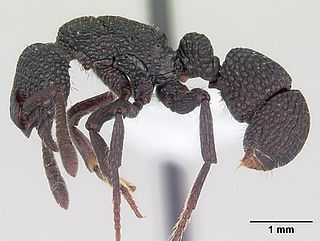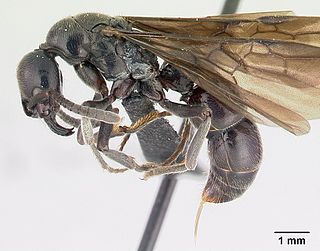
Ponerinae, the ponerine ants, is a subfamily of ants in the Poneromorph subfamilies group, with about 1,600 species in 47 extant genera, including Dinoponera gigantea - one of the world's largest species of ant. Mated workers have replaced the queen as the functional egg-layers in several species of ponerine ants. In such queenless species, the reproductive status of workers can only be determined through ovarian dissections.

Odontomachus is a genus of ants commonly called trap-jaw ants found in the tropics and subtropics throughout the world.

Diacamma is a genus of queenless ants belonging to the subfamily Ponerinae. It is distributed from India to Australia and contains about 24 species.

Anochetus is a genus of small, carnivorous ants found in the tropics and subtropics throughout the world.

Feroponera is a monotypic Afrotropical genus of ants in the subfamily Ponerinae containing the single species Feroponera ferox. The genus is known only from a few specimen collected from an unoccupied termitary in Cameroon.

Hypoponera is a genus of ants in the subfamily Ponerinae. The genus has a worldwide distribution and is found in all continents except Antarctica.

Cryptopone is a genus of ants in the subfamily Ponerinae. The genus has a worldwide distribution, with most species occurring in Asia. Workers range from very small to medium in size (1.7–6.1 mm), with the queens being slightly larger.

Platythyrea is a genus of predaceous ants in the subfamily Ponerinae and the sole member of the tribe Platythyreini.

Loboponera is an Afrotropical genus of ants in the subfamily Ponerinae with nine recognized species. The genus is found in central and western Africa, from Ivory Coast to Rwanda. Little is known about their biology.

Promyopias is an Afrotropical genus of ant in the subfamily Ponerinae containing the single species Promyopias silvestrii. The rare genus has previously been regarded as a separate genus, as a subgenus and as a provisional synonymy, but was reinstated at genus-rank in 2008.

Phrynoponera is a strictly Afrotropical genus of ants in the subfamily Ponerinae.

Bothroponera is a genus of ants in the subfamily Ponerinae. It is distributed in Africa and Asia.

Megaponera analis is the sole species of the genus Megaponera. They are a strictly termite-eating (termitophagous) ponerine ant species widely distributed in Sub-Saharan Africa and most commonly known for their column-like raiding formation when attacking termite feeding sites. Their sophisticated raiding behaviour gave them the common name Matabele ant after the Matabele tribe, fierce warriors who overwhelmed various other tribes during the 1800s. With some individuals reaching up to 25 millimetres (0.98 in) in length, M. analis is one of the world's largest ants.

Rasopone is genus of ants in the subfamily Ponerinae. The genus is restricted to Central and South America.

Ectomomyrmex is a ponerine genus of ants found in Asia and Australia. Little is known about their biology, but they seem to be generalist predators of arthropod prey.

Euponera is a ponerine genus of ants distributed in the Afrotropics and eastern Asia. Workers are large (6–10.5 mm); queen are similar to workers, but larger and winged.

Hagensia is a small genus of ants in the subfamily Ponerinae. Its two species are known only from coastal areas in South Africa. Workers are large (10.5–13.0 mm); queens are unknown, but gamergates occurs in both species.

Mesoponera is an Old World genus of ants in the subfamily Ponerinae. It is found in the tropics, from Sub-Saharan Africa to Australia.
Ophthalmopone is a ponerine genus of ants found in Sub-Saharan Africa. Workers are slender and large in size (8–13.5 mm). Queens seem to be absent, but gamergates present.

Pseudoneoponera is a ponerine genus of ants found from India to Australia, they are mostly non queen species, most of the species within the genus thrives on only gamergates.



















